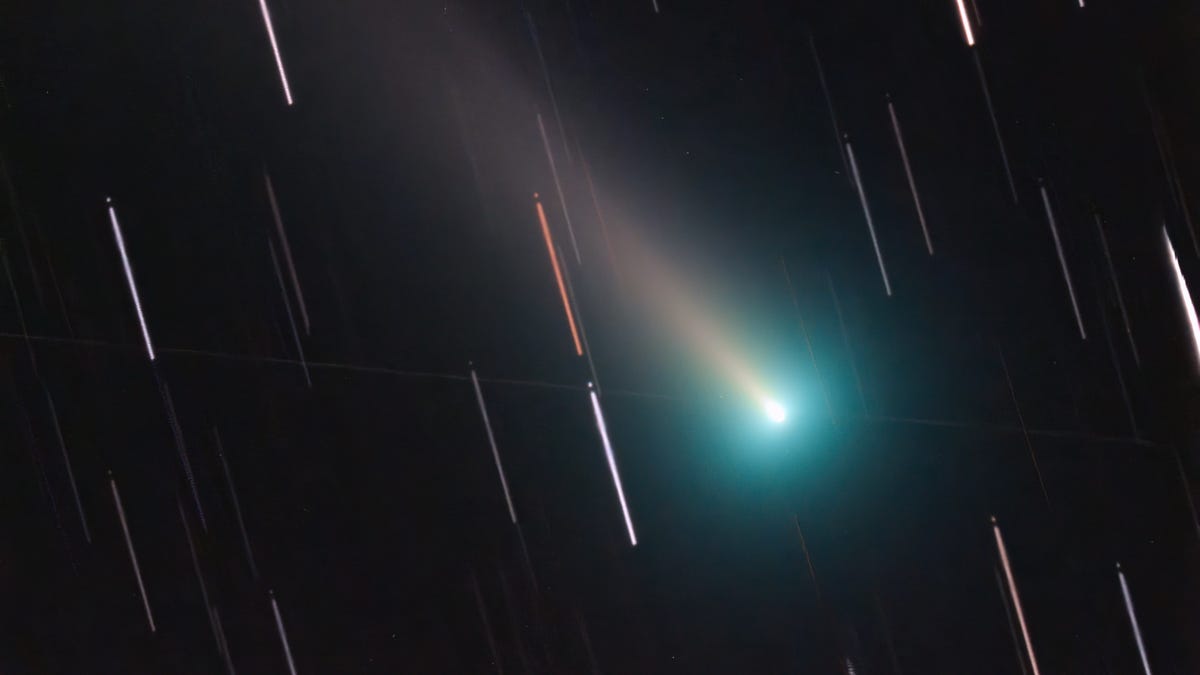See Comet Leonard and its rare 'disconnecting' tail racing toward the sun
The brightest comet of 2021 is almost like two in one right now.

Comet C/2021 A1 Leonard photographed from Indiana on Nov. 28.
Something weird is going on with a holiday visitor from deep space, and it can easily be seen now in evening skies.
At the beginning of 2021, researcher Greg Leonard discovered Comet C/2021 A1, now better known as Comet Leonard. At the time, it was heading in our direction from the outer reaches of the solar system. "The fact that the tail showed up in those images was remarkable, considering that the comet was about 465 million miles out at that point, about the same distance as Jupiter," Leonard said in a statement.
The comet flew by Earth earlier this month and is now heading for its close pass by the sun on Jan. 3. But in recent days something quite unusual has happened to the comet's tail. Astrophotographers have captured what looks a little bit like a tail within the tail, or what astronomer Tony Phillips calls a "disconnection event."
This shot of Leonard was taken from a remote facility in Namibia.
"A piece of the tail has been pinched off and is being carried away by the solar wind," he writes on spaceweather.com.
Phillips says space weather caused by solar flares or coronal mass ejections from the sun could have led to this odd sight.
"Even ordinary solar wind streams hitting comets can cause magnetic reconnection in the comets' ionized tails, sometimes ripping them off entirely."
NASA actually captured this phenomenon when it happened to Comet Encke in 2007:
Comet Encke loses its tail in a 2007 disconnection event.
It's also possible the extra internal tail is just the product of an outburst of debris from the comet's core, indicating that the whole thing may be fragmenting. It's always tough to know what's really going on inside a comet.
Plenty of reports from observers say Leonard is visible to the naked eye or with binoculars, and has occasionally flared to the second magnitude brightness, which is on par with Polaris (also known as the North Star.)
Comet Leonard this morning. Roughly 95 minutes of motion captured with the RedCat and ZWO ASI533MC Pro leading up to dawn breaking (09-Dec). The apparent laser battle going around it are satellites crossing the field of view during the exposure. #CometLeonard pic.twitter.com/UshQe2hPxU
— Dr Adrian Jannetta 🖩🔭🌒🇬🇧🇪🇺 (@AdrianJannetta) December 10, 2021
A number of astrophotographers have managed to snap some pretty impressive shots of Leonard sporting a green coma with a spiffy extended tail.
To see what has at least a chance of becoming a once-in-a-lifetime cosmic event, I recommend putting your location into a tracking app or website like TheSkyLive to get the best time and direction to look.
Comet C/2021 A1 Leonard on Dec 2021 image Michael Jäger pic.twitter.com/Fm9RZeB61i
— Con Stoitsis (@vivstoitsis) December 10, 2021
This'll be our only chance to see Leonard close up. Its journey here from deep space is estimated to have taken about 35,000 years, and the European Space Agency reported via Twitter that the comet's orbit is "slightly unbound to the sun."
We've computed #CometLeonard's future orbit and it appears to be slightly 'unbound' to the Sun – it will likely leave the solar system for good on its way out👋#SomeoneElsesOumuamua☄️ https://t.co/aSbZuOkOPI
— ESA Operations (@esaoperations) December 9, 2021
"This is the last time we are going to see the comet," Leonard said. "It's speeding along at escape velocity, 44 miles per second. After its slingshot around the sun, it will be ejected from our solar system, and it may stumble into another star system millions of years from now."

